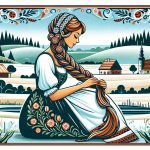
Easter in Poland is celebrated with unique traditions that mix serious religious moments with fun cultural events. From the beautiful Pisanki, where eggs are turned into detailed art pieces, to the exciting Śmigus-Dyngus day, where throwing water is a big part of the celebration, these customs show the rich culture of Poland.
The celebrations start with Palm Sunday and end with Easter Sunday, showing a range of traditions that highlight both the reflective and joyful sides of Polish culture. Let’s dive into how these deep-rooted traditions make the Polish Easter celebration special, offering a peek into a culture that values both thoughtfulness and fun.
The Prelude: Palm Sunday
In Poland, Palm Sunday kicks off Holy Week and is locally known as Niedziela Palmowa. This day stands out because of a special tradition where people bless palm branches. These aren’t just any branches, though. They’re woven with care and decorated with dried flowers and colorful ribbons, making them much more than simple greenery. They carry deep meanings, symbolizing Jesus’ entry into Jerusalem and the broader theme of life triumphing over death, which coincides with the arrival of spring.
Creating these palms is more than a religious ritual; it’s an art form that combines faith with creativity. It’s a chance for people to express themselves and connect with their cultural roots. In Poland, there’s a real sense of community as people gather to craft these palms, each adding their personal touch. Some communities even hold contests to see who can create the most elaborate palm. This competition isn’t just for fun; it’s a reflection of the tradition’s importance in Polish Easter celebrations.
Let’s dive a bit deeper into what makes these palms so special. Imagine walking into a Polish church on Palm Sunday and seeing a sea of vibrant colors from the palms held by the congregation. Each palm tells a story, not just of biblical times but of the person who made it. The dried flowers might be from a family garden, and the ribbons could have been chosen by children, all woven together by skilled hands. This blend of personal and communal efforts showcases the strength of Polish traditions.
If you’re curious about how to make these palms or want to see them up close, Poland during Holy Week is the place to be. You’ll not only witness this unique tradition but also experience the warmth and hospitality of the Polish people. For those who can’t travel, looking up online tutorials or visiting Polish cultural centers might offer a glimpse into this fascinating aspect of Easter celebrations. Engaging with this tradition, whether by making a palm yourself or simply learning about it, offers a window into the rich tapestry of Polish culture and the universal themes of hope and renewal that Easter brings.
Holy Week Observances
In Poland, Holy Week begins right after Palm Sunday and is a time filled with meaningful customs that showcase the country’s deep religious roots and cultural identity. This period is a mix of reflection, community, and anticipation leading to Easter.
The week starts to intensify on Holy Thursday, known as Wielki Czwartek. This day, people go to church to remember the Last Supper. It’s a time to reflect on togetherness and the sense of belonging within the community. It’s a powerful reminder of unity. For example, attending mass on this day, you can see the congregation come together, participating in rituals that have been passed down through generations, strengthening their communal bonds.
Good Friday, or Wielki Piątek, brings a more somber tone. The day is characterized by quiet processions and the veneration of the Cross. This act serves as a vivid symbol of sacrifice and the hope for salvation. It’s a day of deep reflection. In many Polish towns, the processions are elaborately staged, involving the entire community in re-enactments of the Stations of the Cross, making the historical events of Jesus’ crucifixion relatable and immediate.
Then, there’s a noticeable shift on Holy Saturday, or Wielka Sobota, which lightens the atmosphere with the tradition of blessing Easter baskets, known as Święconka. These baskets, often filled with symbolic foods like eggs, bread, and salt, represent new life and the joy of the Resurrection. It’s a colorful and joyful celebration, with families preparing their baskets together, choosing the items with care, and then bringing them to church to be blessed. This act not only enriches the spiritual significance of the food but also underscores the importance of family and community in Polish culture.
Throughout these days, the focus is not just on religious observances but also on bringing people together, reinforcing shared values, and preparing for the joyous celebration of Easter. Each tradition, from the solemn to the celebratory, is imbued with deep meaning, connecting the past with the present in a continuous thread of faith and community life.
The Art of Pisanki
Pisanki, a traditional Polish Easter egg decorating technique, stands out for its rich cultural significance and stunning visual appeal. This tradition dates back to pre-Christian times, originally symbolizing nature’s renewal. Over the centuries, Pisanki has evolved into an elaborate folk art, deeply rooted in symbolism and showcasing exceptional craftsmanship. Artisans employ various methods such as wax-resist dyeing, etching, and painting to turn ordinary eggs into elaborate works of art. These eggs often feature detailed patterns, including geometric shapes, floral designs, and religious symbols.
Each decorated egg tells a story, reflecting the cultural heritage and beliefs of different Polish regions. For example, eggs from one area might display bright, geometric patterns, while another region’s eggs could feature delicate floral designs, highlighting the diversity within Poland’s cultural identity. Pisanki is more than just an Easter decoration; it’s a way of preserving and sharing Poland’s rich traditions and values from one generation to the next.
For those interested in experiencing this art form firsthand, there are workshops and kits available that guide beginners through the basic techniques of Pisanki. These resources often include everything needed to start, such as dyes, wax, and tools, making it easy for anyone to create their own Pisanki eggs. By participating in this tradition, people not only learn a new craft but also connect with an important aspect of Polish culture.
Easter Day Festivities
Easter Day in Poland is a vibrant celebration, deeply rooted in the country’s religious beliefs and community values. The festivities start early with families heading to church for the Resurrection Mass at dawn. This service celebrates Jesus Christ’s resurrection and is a joyful occasion. During the mass, people share ‘święconka,’ which are Easter eggs blessed the previous day, Holy Saturday. It’s a beautiful tradition that highlights the theme of renewal and life.
After the mass, families return home to a lavish feast. This meal is special because it includes foods that were not eaten during Lent, like lamb, ham, and various cakes and breads. The food is not just about indulgence but also symbolizes the end of Lenten sacrifices and the beginning of a new season. It’s a way for people to gather, share, and celebrate the essence of Easter and spring.
These Easter traditions in Poland do more than just mark a religious holiday; they bring people together, reinforcing a sense of community and shared heritage. The practices, from attending mass to sharing a meal, underscore the importance of family and collective identity. They are vivid examples of how traditions can keep a culture alive and meaningful across generations.
In a nutshell, Easter in Poland is a rich blend of religious significance and communal joy. The day is packed with customs that not only honor the resurrection of Jesus but also celebrate the bonds between people. It’s a time of spiritual reflection and communal joy, making it one of the most cherished times of the year in Poland.
Śmigus-Dyngus Celebrations
Easter Monday in Poland brings a fun tradition known as Śmigus-Dyngus. This day moves away from the solemnity of Easter to a more playful atmosphere. The tradition has its roots in ancient pagan rituals that welcomed the spring season. On this day, people splash water on each other. This custom started with young men sprinkling water on young women, a practice believed to encourage fertility and good fortune. Nowadays, the celebration includes everyone, turning into a massive water fight that brings joy across all age groups.
This change from a simple sprinkling to an all-out water battle shows how Polish traditions adapt over time while still keeping their core values. Such activities not only preserve cultural heritage but also adapt it to fit the modern world, making traditions more inclusive and enjoyable for everyone. This evolution is a clear sign of the Polish people’s ability to maintain their cultural identity while embracing change.
Community plays a huge role in Śmigus-Dyngus. By participating in this water fight, people strengthen their connections with each other, creating a sense of unity and belonging. This tradition is more than just fun; it’s a way for the community to come together and celebrate their shared heritage.
Conclusion
To sum it up, Easter in Poland is a mix of religious practices, cultural customs, and community activities. Starting with the detailed preparations for Palm Sunday and ending with the fun Śmigus-Dyngus water fights, each part of the celebration has a special meaning that goes beyond just having a good time.
This look into Polish Easter shows us the unique traditions that make it stand out, highlighting how these customs are part of the wider cultural and spiritual life in Poland.






Comments are closed.